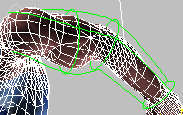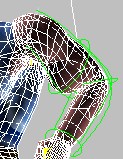Bulges simulate bulging muscles. Physique creates bulges based on bulge angles and cross section shapes you specify, not on
keyframe settings.
You create a bulge by:
- Reposing the character to a position where the bulge will have its greatest effect. This can just be a matter of using the
time slider to scrub to that place in a loaded motion file.
- Setting a bulge angle between two links, the currently selected link and its child link in the hierarchy. The bulge angle
is the angle of the joint where the bulge has its full effect. When the joint has a different angle, Physique interpolates
so the bulge can grow as the joint flexes toward that angle. See Setting Bulge Angles for more information.
NoteThe resulting bulge for any given frame in an animation is determined by the interpolated effects of all bulge angles for
the link, based on the relationship of each bulge angle to the current joint angle. Bulge angles are not directly associated
with keyframe parameters, but are relative to the skeleton's behavior.
- Creating and shaping the cross sections associated with the bulge angle. A link's cross sections and its profile are spline
controls of the shape of the skin. To create and shape cross sections, see Shaping the Bulge.
Each bulge angle affects both neighboring links. Therefore, each link contains a set of cross sections for each bulge at both
its parent and child joint angles. For example, the forearm link can be deformed by bulge angles associated with both the
elbow and wrist joints.
- Adjusting bulge parameters, including the joint intersection parameters. Bulge parameters control the smoothness and the strength
of the bulge and are found at the Bulge sub-object level.
Joint intersection parameters control how the skin behaves when bulges would overlap each other if there were no collision
detection for skin vertices. They are in a Physique rollout for Link sub-objects. See Reinitializing Physique Settings.

